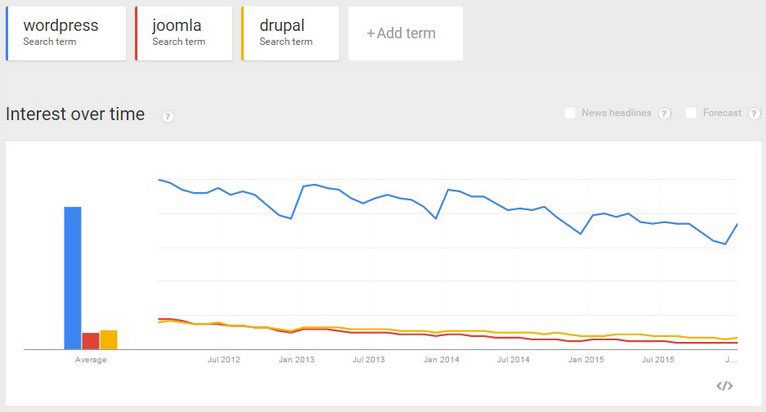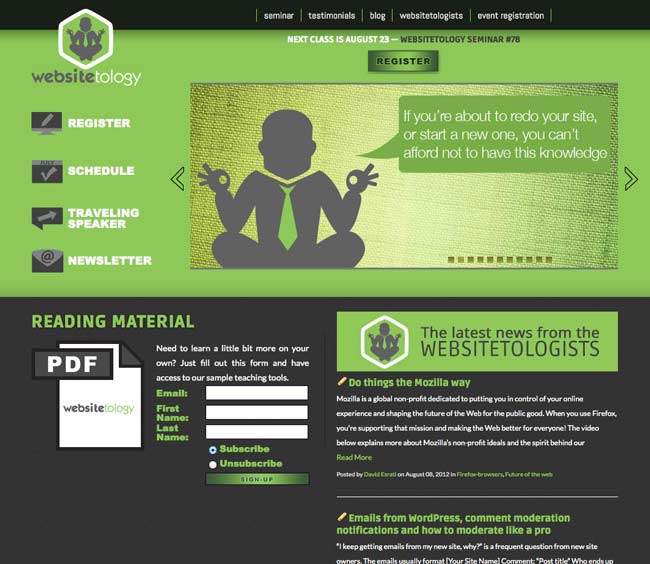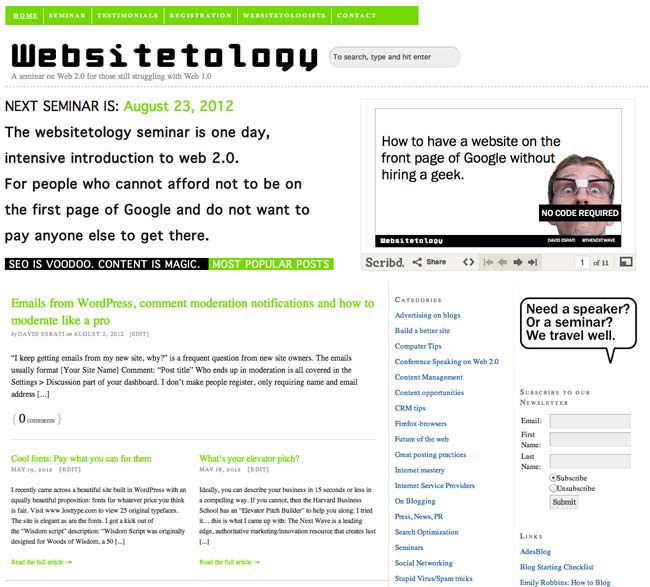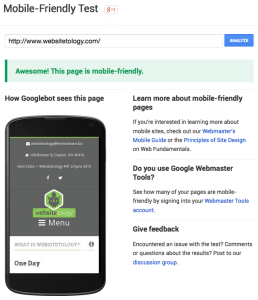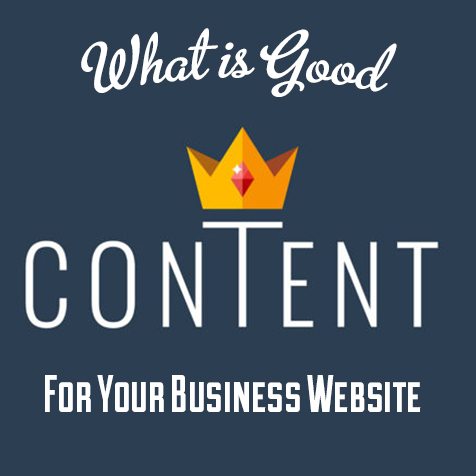 Sadly, this post needs to be written. Mostly, because people have come to the conclusion that “Likes” and “Shares” and “Clicks” and “Views” and all those other “metrics” of success are what is easy to measure.
Sadly, this post needs to be written. Mostly, because people have come to the conclusion that “Likes” and “Shares” and “Clicks” and “Views” and all those other “metrics” of success are what is easy to measure.
There are only two things that matter: you can solve a customers problem, and they can find you quickly.
If you can solve their problem and they can find you- you should be able to make money and continue your business venture. Which brings us back to the question “What business are you in?” which is another question that most businesses should know- but many don’t.
On the internet you are always a click away from your competition- and at the mercy of Google for generating you leads. That’s why the “You gotta be on the first page of Google” is so important- because, you, me and everybody else usually picks their solution off the first page of Google.
Understanding how Google works is really critical, and it’s one of the most important parts of our Websitetology Seminar. Anyone who tells you that they can get you organically (not paying for an ad) to the front page of Google for X dollars per month is selling you crack. You’ll get addicted- and while they may get you there for 10 search terms, doing your site right should get you hundreds of search terms. At least if you use WordPress as your Content Management System and fully understand what kind of content and how to post properly.
When it comes to content- think about what you search for. Usually it’s to solve a problem- be it the “best price for business card printing in Dayton Ohio” which should take you to The Next Wave Printing, where 500 4/c 2/s 16pt business cards can be had for $13.50 plus tax from your press ready files. On my search, we come up 7th- on the first page. Which is great, but, the likelihood of us making a sale is kinda slim with all those other printers ahead of us.
As usual, the cobblers kids need new shoes, and we should optimize better, but here’s the thing- we’re not primarily in the printing business. We’re an ad agency, that believes that much of the printing has become a commodity- and we’re using low printing prices as a way to attract clients who need a great full service ad agency in Dayton Ohio.
The problem is, we just helped optimize the printing site for one term – “Best price for business card printing in Dayton Ohio” and you may have searched for “Cheap business card printing in Dayton Ohio.” Where we come in 2nd. As you can guess- there are a ton of search terms to optimize for – and all have different results. So, optimize away, but the real key these days is referrals, and recommendations.
And if you didn’t catch it, we’re seamlessly and shamelessly posting referral links about another of our business sites in this post, with the hope you click on over. Building “link juice” or “google cred” is a part of the formula. Who links to you, how much traffic you get, how much traffic they get, is all analyzed as part of the algorithm that makes Google work. And remember, everyone gets different results from Google based on the personalized search history you’ve built.
People often will ask their friends via Linkedin or Facebook- who has the best prices on business card printing in Dayton Ohio- and they may or may not know anything about your business and say we used “StupidCheapBusinessCards.com” for ours and they were fine. Nevermind Stupid Cheap prints on 100lb cover, charges $14,95 plus shipping.
This is where companies start making mistakes- going into social networks and telling everyone “We have the best prices on Business Cards in Dayton Ohio” when the discussion is about a tax levy. You become noise, irritating, obnoxious, and sometimes- blocked.
Making sure every business that uses you writes a review on Google Local, Facebook, LinkedIn or Yelp, Foursquare, Trip Advisor can help- some more than others, but, usually, the key is for your customers to spread the word for you. Making it easy to share the great value and service you provided is usually worth a lot more than just being at the top of Google.
Which brings us back to what is the best content for your site? It’s useful posts that solve the customers problem- sometimes before they even realize they have one. Do you provide all your service manuals, instructions, ads, warranty information, repair and return policies, hours, locations, and anything else they may need to know in order to do business with you.
Do you offer tutorials, how to’s and step-by-step content? You should.
We looked at a site today for a local diner to find the menu to order carryout lunch. The site greeted us “Coming this spring” (it’s fall) and the “Menu” didn’t have prices. Not good. There were no reviews (probably a good thing- we thought the bread was mediocre, the chips run of the mill and the sandwiches were soggy). We hadn’t looked at reviews first, but, if any of our friends ask about this new place, we probably won’t suggest it. We also believe it’s much better to have people review you on your own site- instead of on one of those other sites, because you can address it easily (note- most of the review sites mentioned provide tools you can use to monitor and respond to reviews- make sure you claim your business.).
If you still have questions about what is good content- it solves your customers problem, and it’s something that helps them find you. If you want a customized recommendation list for content generation, we’re here to help, or you can take the Websitetology Seminar and learn the secrets of best posting policies and how all this fits together.
Our completely committed endorsement of WordPress is no secret, you’ll hear from us on this website and in our seminar that WordPress is the best content management system for a business owner building their site. It’s at home with techies just as much as it’s easy to use for people who have a casual relationship with the web.
However, this doesn’t mean we live in a vacuum; we keep an open mind to new and other currently existing web technologies, as well. If something even better than WordPress were to appear that made website creation and maintenance easy while keeping up with tech trends and searchability, we’d try to be the first to tell anyone about it. To this end, we continue to keep up our knowledge with other content management systems like Joomla and Drupal, among others. The rest of the web has generally trended towards what makes sense, too, which is why WordPress makes up nearly half of all websites. Take a look at the following stats we gleaned from BuiltWith:
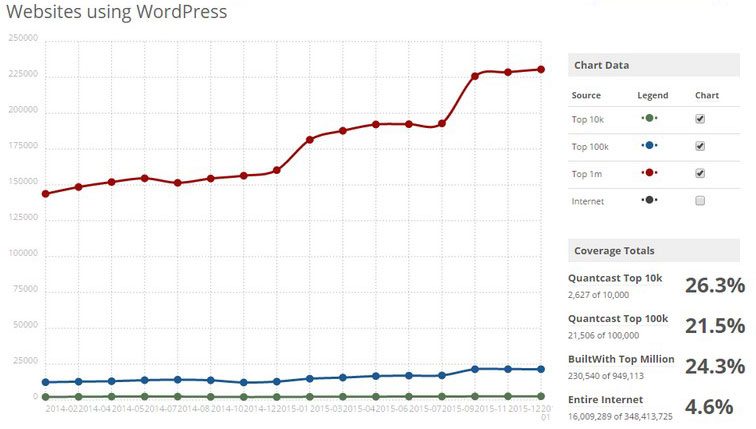
With 2016 getting started, it doesn’t look like we’re in any rush to change our 10 years of web content: WordPress is here to stay. Better yet, usage is increasing. As for the other big players—Joomla and Drupal—they’ve continued on a downward trend which has been going on for years (all 3 experienced a sharp increase in one month in 2015, likely a change in measurements).
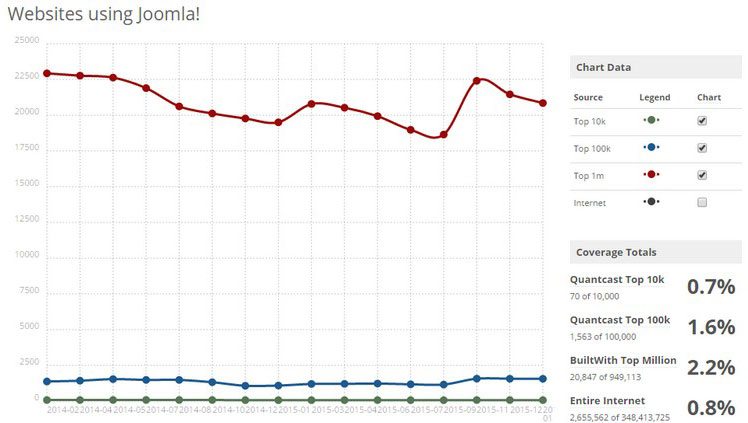
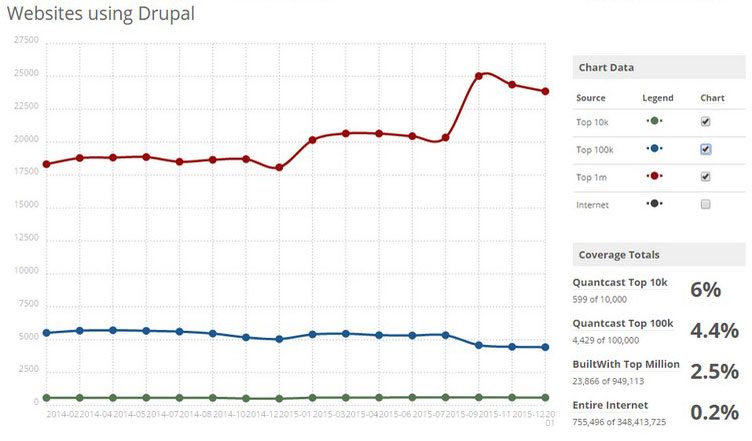
Keep in mind that in these charts, WordPress is measured on a completely different scale than the other two, ten times larger in fact.
Going with the consensus is often a good thing in terms of tech adoption. In this instance, large scale adoption means more robust support, a much larger pool of plugins and themes to choose from, and much lower likelihood that your website will become obsolete anytime soon and require a complete rebuild from the ground up. How many sites do you still see built on Flash in 2016? Also consider that the site you’re reading right now has existed on WordPress more or less in the same state for over 10 years now. A website that has to be continually rebuilt from scratch is oftentimes treated as a completely new website in the eyes of Google’s indexing bots. Crawling through a website built on WordPress is like cutting open a tree and counting the rings inside: a more detailed history than you’d ever need.
If you’ve been following us a while, you might remember our post all the way back in 2012, where we unveiled our newest, shiny design to bring us into the twenty-teens. The adage about cobblers and shoes we used then once again started ringing true in 2015. We’ve always been in the loop about what makes a great website, even from a design standpoint, but usually those things were reserved to our clients over at The Next Wave and spreading the word to our seminar attendees.
So much has changed even in the three years since our previous design. The biggest of which is the rise of responsive web design, which allows a website to adapt to whatever device a user is viewing the website so that it never looks wrong. With this technology comes a “mobile-first” approach to design, in which websites are designed with mobile devices in mind, then scaled up and enhanced for laptops and desktops.
With Google’s mandate that sites be mobile friendly or face consequences in the search engine rankings, we knew we couldn’t wait around any longer to give our site a new facelift. So if you’re reading this post on our website, you’re looking at the new Websitetology design.
Maybe the space aesthetic isn’t your thing. That’s cool. The great thing about the way this site was designed and coded is that the thematic images throughout the site, including the slides on the homepage, can be easily swapped out for new ones without altering a single bit of code. We can return to Earth and give the site a fresh look at a moments notice.
So what do you think? Love it? Have any constructive criticism? Leave your comments below.


